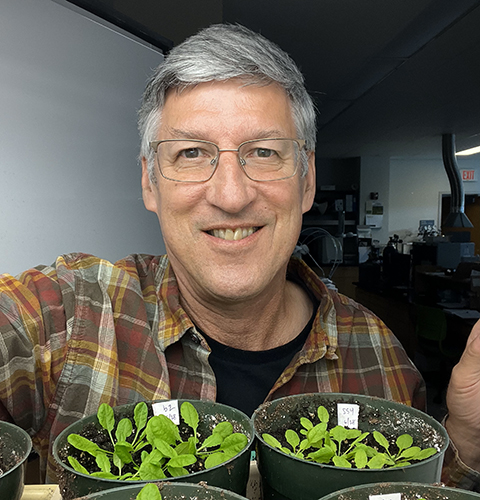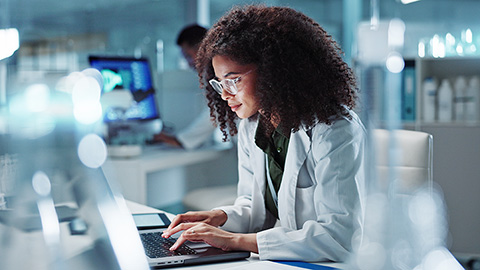The fourth third of my career: Living the dream
I enjoyed being a postdoc, except for the constant worry about getting a permanent job. I could focus on research without having to teach or serve on committees. After a few decades of being a professor, I thought it would be fun to return to that type of position after retiring. This is the story about how I made that happen in the chemistry and biochemistry department at James Madison University in Virginia, with the hope that it might inspire others to do the same.
I spent 31 years in the biology department at JMU — a large, state-supported, primarily undergraduate institution, or PUI, with an emphasis in the sciences on undergraduate research. Each faculty member teaches two to four courses per semester, and we do research, but compared with research at R1 institutions, we tend to publish less frequently, and our papers are rarely in journals with very high impact factors. Research expectations vary by discipline but in chemistry and biochemistry at JMU, a faculty member needs three publications for each promotion.

When I entered the job market, I, like many graduate students and postdocs at R1 institutions, didn’t know much about PUIs or how best to market myself for a position at a PUI. Soon after coming to JMU in 1992, I thought I would spend a few years there, then move to an R1 before gaining tenure. I was surprised by how much my thinking changed after the first few years.
Teaching turned out to be quite enjoyable. I loved working with students in the lab: demonstrating the art of pipetting, convincing them that controls are important, and watching the lightbulbs come on when they made connections. I also enjoyed collaborating on research and teaching with my colleagues who were nice people that I liked spending time with. It wasn’t the cutthroat, pressure-cooker environment I had envisioned, and I was happy.
A year after I started at JMU I went to a meeting of the Council on Undergraduate Research, or CUR, a national organization that, according to their mission, “supports and promotes high-quality mentored undergraduate research, scholarship, and creative inquiry.” I was energized by the realization that lots of PUI folks across the country were all trying to do the same thing, and CUR was there to support them. I stayed at JMU my entire career and loved nearly all of it.
My first three thirds
In the first third of my career at JMU, I did enough research and service to get tenure, but my passion was teaching. I honed my lecture style to be as inspirational as I could, developed several course-based undergraduate research experiences, and co-led a change in our curriculum.
Over the second third of my career, I developed my leadership skills at the American Society of Plant Biologists, or ASPB, and at CUR, serving on both of their executive committees. I also served as an interim department head and as the webmaster for the biology department. The interim head gig was good for the department, but it cured me of any further administrative aspirations. I also spent a few years as a textbook coauthor.
Then, during the third third of my career, my research activity blossomed. I spent more time reading the literature and doing more experiments alongside my students at the bench, and I discovered several interesting things about plant starch metabolism.
Focusing on research was made possible by two important factors – I learned how to say “no” more often, and I developed a strong and mutually productive collaboration with Chris Berndsen, a colleague in JMU’s chemistry and biochemistry department. His protein structure and biochemistry skills complemented my plant physiology and molecular biology skills. Together, we developed a research program describing the structure and cellular function of beta-amylases, which we funded with a string of National Science Foundation Research at Undergraduate Institutions grants.
Students working on this project spent time in both laboratories getting guidance from each of us and performing experiments in each of our specialty areas. Further, we and our students traveled to the ASBMB or ASPB annual meetings each year. The collaboration had a big impact on our productivity: 13 papers from the two labs over the last eight years, five with both mentors.
Retiring as a postdoc
All of this leads me to the fourth third of my career. I had grown weary of teaching, especially post-COVID, and my tolerance for committee meetings was waning. These activities took considerable time away from what gave me the most pleasure: thinking about experiments and working with students at the bench.
What I really wanted to do was to be a postdoc again, without all the pressures and responsibilities of being a professor. To be honest, I had been telling friends and colleagues of this postretirement desire for decades. The existing collaboration with Chris provided the perfect opportunity.
In the fall of 2023, I retired at 63, became an emeritus professor and moved into Chris’s lab in the neighboring building. Chris can pay me modestly from the latest NSF grant on which I am the co-PI, but that isn’t why I’m doing it. It’s fun, it keeps me thinking, and I feel useful to Chris and to the world. I get to help mentor research students, and faculty meetings are history.
I faced some challenges in making this arrangement work. First was communicating to the administration what my position was at the university. Since I do not teach and research postdocs and research faculty effectively don’t exist at JMU, I had to use broad communication to define my role to the institution. This process was aided by having the NSF grant in which the position and expectations were clearly defined.
Second was merging two previously separate research programs into a single unit. Because Chris and I had worked together for nearly a decade, this was not a huge hurdle, but we had to find space for my Arabidopsis plants in the Physics and Chemistry Building and places in Chris’s lab to store the residual supplies from my career. Thirty-one years of experiments leads to the accumulation of a lot of stuff.
Finally, what is my place in the lab from the perspective of the undergraduates? A few of Chris’ students knew me in my previous role and we had to define early on where I fit into the existing team. Fortunately, the students quickly adapted to calling me Jon, and I slid into my role as something like a postdoc well. Both Chris and I have adjusted to the new working relationship where he is the boss, through clear communication and knowing that this is a process.
A recipe for success
Many of our academic organizations and funding agencies have well-crafted programs to help scientists get started in their careers (think workshops sponsored by NSF, ASBMB, ASPB, or CUR on grant writing, mentoring, teaching, and lab set-up), and those are very beneficial. However, programs to assist faculty at the other end of their careers are entirely lacking.
Wouldn’t it be nice to have a program that allows a faculty member who wants to continue doing research after they retire to pair up with a junior or mid-career faculty member and assist with their research program?
The senior member could be a mentor for the junior faculty member and some of their students, especially when the junior is teaching. The retired faculty scientist can be a sounding board for wild ideas and provide a complementary set of skills and an extra set of hands in the lab.
Being retired and not looking for the next job or promotion, the senior partner can carry out the riskier experiments that are less likely to succeed. In exchange for these efforts, they should be compensated but at a more modest level.
The benefits of such a program for junior or mid-career faculty and the broader scientific community are easy to find. These benefits would especially impact PUIs, where the heavier teaching loads can limit the time and opportunities for faculty to teach research skills to the many undergraduates who might benefit. Thus, this type of program could provide additional resources and avenues for success for undergraduates.
We all hope to find happiness and rewarding experiences after retirement, and that can happen in a wide variety of ways. For me, being able to use my professional skills and creativity in a less pressured way was in the back of my mind for a long time. Now I can truly claim that I am living the dream.
Sincere thanks to Chris Berndsen for his contributions to this essay.
Enjoy reading ASBMB Today?
Become a member to receive the print edition four times a year and the digital edition monthly.
Learn moreFeatured jobs
from the ASBMB career center
Get the latest from ASBMB Today
Enter your email address, and we’ll send you a weekly email with recent articles, interviews and more.
Latest in Careers
Careers highlights or most popular articles

Designing life’s building blocks with AI
Tanja Kortemme, a professor at the University of California, San Francisco, will discuss her research using computational biology to engineer proteins at the 2026 ASBMB Annual Meeting.

Upcoming opportunities
#ASBMB26 late-breaking abstract submission opens on December 8. Register by Jan. 15 to get the early rate on our Annual Meeting.

Make your abstract stand out
Ensure your research is impossible to overlook. Get quick, practical reminders for crafting an abstract that attracts readers and helps you build connections at the conference.

Inside industry postdocs
As more Ph.D. scientists look beyond academia, industry postdocs offer a new kind of training, where mentorship meets mission-driven research. Fellows at Pfizer and Genentech share how these programs prepare them to translate discovery into impact.

Upcoming opportunities
The Lipid Research Division Seminar Series returns Oct. 15 with talks on recent advances in triglyceride cycling in adipocytes.

Writing with AI turns chaos into clarity
Associate professor shares how generative AI, used as a creative whiteboard, helps scientists refine ideas, structure complexity and sharpen clarity — transforming the messy process of discovery into compelling science writing.

